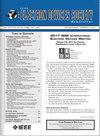基于DNTT有机半导体的低压薄膜光电晶体管的动态响应
IF 2.4
3区 工程技术
Q3 ENGINEERING, ELECTRICAL & ELECTRONIC
引用次数: 0
摘要
分析了下栅极/上接触结构下的有机场效应晶体管对光的动态响应。我们在柔性PEN(聚萘二甲酸乙二醇酯)衬底上通过阴影掩膜蒸发薄膜层,制备了Al/Al2O3/SAM/DNTT/Au光电晶体管。该结构由铝层作为栅极,金层作为源极和漏极。DNTT (Dinaphtho[2,3-b: $2^{\prime}$, $3^{\prime}$ -f]thieno[3,2-b]噻吩)为活性有机半导体层,Al2O3为介电常数高的介电材料。采用自组装单层膜(SAM)改善Al2O3与DNTT之间的粘附和界面性能。对蓝光敏感的晶体管在低电压下偏置(Vgs和$\mathrm {V_{ds}}$从0到3.5 V),器件显示出低$\mathrm {I_{gs}}$漏电流,约为$5x10^{-10}$ A,并且对光有清晰的电光响应。在静态状态下,最大响应值约为0.21 A/W,而在动态状态下,产生可测量响应的最低辐照度为13~\mu $ W/cm2。所分析的光电晶体管的光响应上升时间的快速时间分量,在几百毫秒的数量级,被证明是Al/AlOx/DNTT/Au有机光电晶体管中最快的文献之一。这些初步结果对开发用于可见光通信的有机光电晶体管具有鼓舞作用。本文章由计算机程序翻译,如有差异,请以英文原文为准。
Dynamic Response of Low-Voltage Thin Film Phototransistors Based on DNTT Organic Semiconductor
We analyzed the dynamic response to the light of organic field-effect transistors in bottom-gate/top-contact configuration. We fabricated Al/Al2O3/SAM/DNTT/Au phototransistors by evaporating thin film layers through shadow masks on flexible PEN (polyethylene naphthalate) substrates. The structure is composed of Al layer as the gate electrode, and Au used both for Source and Drain electrodes. DNTT (Dinaphtho[2,3-b: $2^{\prime }$ , $3^{\prime }$ -f]thieno[3,2-b]thiophene) is the active organic semiconductor layer and Al2O3 is the dielectric material, chosen for the high value of the dielectric constant. SAM (self-assembled monolayer) was used to improve adhesion and interface properties between Al2O3 and DNTT. The transistors, sensitive to blue light, were biased at low-voltage (Vgs and $\mathrm { V_{ds}}$ from 0 to 3.5 V). Devices showed low $\mathrm { I_{gs}}$ leakage currents, of the order of $5x10^{-10}$ A, and a clear electro-optical response to the light. The maximum responsivity value was about 0.21 A/W in the static regime, while the lowest irradiance producing a measurable response in dynamic regime was $13~\mu $ W/cm2. Fast time components of the rise time of the light response for the analyzed phototransistors, of the order of few hundreds of ms, turned out to be among the fastest reported in literature for Al/AlOx/DNTT/Au organic phototransistor. These preliminary results are encouraging for developing organic phototransistors for visible light communication.
求助全文
通过发布文献求助,成功后即可免费获取论文全文。
去求助
来源期刊

IEEE Journal of the Electron Devices Society
Biochemistry, Genetics and Molecular Biology-Biotechnology
CiteScore
5.20
自引率
4.30%
发文量
124
审稿时长
9 weeks
期刊介绍:
The IEEE Journal of the Electron Devices Society (J-EDS) is an open-access, fully electronic scientific journal publishing papers ranging from fundamental to applied research that are scientifically rigorous and relevant to electron devices. The J-EDS publishes original and significant contributions relating to the theory, modelling, design, performance, and reliability of electron and ion integrated circuit devices and interconnects, involving insulators, metals, organic materials, micro-plasmas, semiconductors, quantum-effect structures, vacuum devices, and emerging materials with applications in bioelectronics, biomedical electronics, computation, communications, displays, microelectromechanics, imaging, micro-actuators, nanodevices, optoelectronics, photovoltaics, power IC''s, and micro-sensors. Tutorial and review papers on these subjects are, also, published. And, occasionally special issues with a collection of papers on particular areas in more depth and breadth are, also, published. J-EDS publishes all papers that are judged to be technically valid and original.
 求助内容:
求助内容: 应助结果提醒方式:
应助结果提醒方式:


